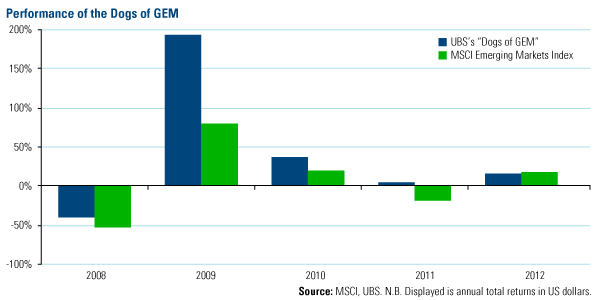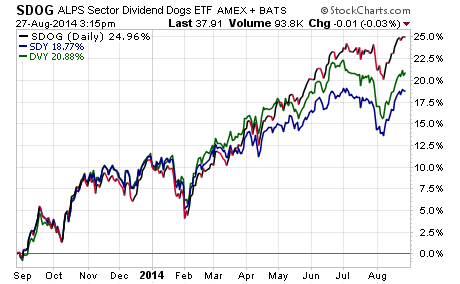Dogs of The Dow Historical Analysis of High Yielding Blue Chip Stocks Sure Dividend Sure Dividend
Post on: 12 Апрель, 2015 No Comment

Dogs of The Dow: Historical Analysis of High Yielding Blue Chip Stocks
- The Dogs of The Dow strategy looks for high yielding blue chip stocks
- The strategy was popularized in 1991
- See the Dogs of The Dow’s performance over the last decade
The Dogs of the Dow investment strategy is very simple. Here are the steps:
- Sort the 30 stocks in the Dow Jones Industrial Average by dividend yield
- Purchase the 10 highest yielding dividends stocks
- Rebalance and repeat steps 1 and 2 at the beginning of each year

The Dow Jones Industrial Average is made up of large blue chip stocks. The Dogs of the Dow strategy looks for the cheapest of these stocks based on their dividend yields. The idea behind the Dogs of The Dow strategy is to purchase high quality businesses at cheap prices relative to their peers. The strategy was popularized in 1991 by Michael B O’Higgins in his book Beating the Dow.
The Dow Jones Industrial Average aims to represent the total US economy with its constituents. Because of this, the Dow is heavily diversified, with most stocks coming from different industries. The diversification of the Dow Jones Index helps the Dogs of the Dow strategy to maintain an adequate level of diversity no matter what 10 stocks are selected each year.
The Dow Jones Industrial Average Changes Over Time
The Dow Jones Industrial Average is adjusted periodically to account for changes in the US economy and from the specific constituents in the index. These changes help the Dow Jones Industrial Average more closely match the performance of the overall stock market. The image below shows the constituents of the Dow Jones Industrial Average by year from 2005 to 2014 at the beginning of each year. If a cell is shaded in blue, the stock is included in the Dow Jones for that year. If a cell is shaded in red, the stock is not in the Dow Jones for that year.
What Stocks Does The Dogs of The Dow Select?
Price movements and dividend changes impact the dividend yields of the Dow Jones constituents. As a result, the stocks the Dogs of the Dow strategy selects change each year. Additionally, adding or removing stocks from the Dow Jones Industrial Average impacts the rankings of the Dogs of the Dow strategy.
With that said, the strategy has a low overall turnover ratio. Over the last 10 years, the Dogs of the Dow strategy had a turnover ratio of 22.22%; on average, 2.22 positions were changed each year. The image below shows what stocks were selected by the Dogs of the Dow strategy over the last decade.
Performance
Over the last decade, the Dogs of the Dow strategy has not managed to beat the Dow Jones Industrial Average. The performance numbers below do not include dividends. which would give the Dogs of The Dow strategy an additional 1.5 percentage points a year return over the Dow Jones Industrial Average. At the beginning of 2014, the Dogs of The Dow strategy had a yield of 3.56%, versus just over 2% for the Dow Jones Industrial average. Despite this boost, the Dogs of the Dow strategy appears to underperform:
Key Take Aways
The Dogs of The Dow strategy takes an interesting approach to outperforming a broad index. Based on my analysis, investors using the strategy have underperformed the Dow Jones Industrial Average over the last decade.
The underperformance likely stems from confusing high dividend yields with true value stocks. A stock can have a 3% dividend yield and a P/E ratio up to 33.3 if it has a 100% payout ratio. A 3% yielding stock would make the Dogs of the Dow list most years, but would be far from a good investment. I believe the Dogs of The Dow strategy fails to account for other relevant factors in investing such as: growth, price volatility, and payout ratio.
With that said, the strategy is very interesting and intuitive. It performs well for a simple non-index fund strategy despite underperforming its bench mark over the last several decades. In a future post, I will examine how using the ‘Dogs of the Dow’ strategy on the Dividend Aristocrats Index would have performed over the last decade, and compare the two strategies.














